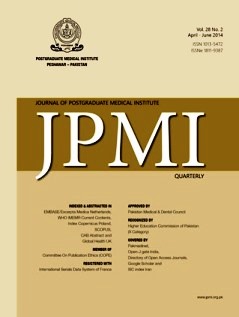Frequency and pattern of distribution of antenatally diagnosed congenital anomalies and the associated risk factors
Main Article Content
Abstract
Objective: To find the frequency and pattern of distribution of antenatallydiagnosed congenital anomalies and the associated risk factors.Methodology: This descriptive study was carried out at the department ofObstetrics and Gynecology, Lady Reading Hospital Peshawar from March 2012to April 2013. Women with ultrasound report of congenitally abnormal fetusirrespective of the gestational age were included. They were evaluated for thepresence of risk factors including periconceptional use of folic acid, maternalmedical disorders e.g diabetes, epilepsy and history of smoking, maternal andpaternal ages, consanguineous marriages and family history of anomalies.Results: A total of 62 women were included in the study. Fifty seven (91.9%)were having isolated anomalies while 5 (8.1%) presented with complex anomalies.Central nervous system (CNS) was the most commonly involved system(79%). Lack of folic acid use and consanguineous marriages were two mostimportant risk factors; however their correlation with congenital anomalieswas not significant. Forty eight (77.4%) women have never used folic acidand consanguineous relation was present in 52 (83.9%). Other risk factors likematernal medical disorder e.g. diabetes, epilepsy, maternal and paternal ages,family history and maternal smoking were non-significant.Conclusion: Lack of periconceptional use of folic acid and consanguineousmarriages were two most important risk factors. Awareness among the generalpopulation and improvement in the antenatal care can help in the earlydetection and management of congenital anomalies.
Article Details
Work published in JPMI is licensed under a
Creative Commons Attribution-NonCommercial 2.0 Generic License.
Authors are permitted and encouraged to post their work online (e.g., in institutional repositories or on their website) prior to and during the submission process, as it can lead to productive exchanges, as well as earlier and greater citation of published work.


